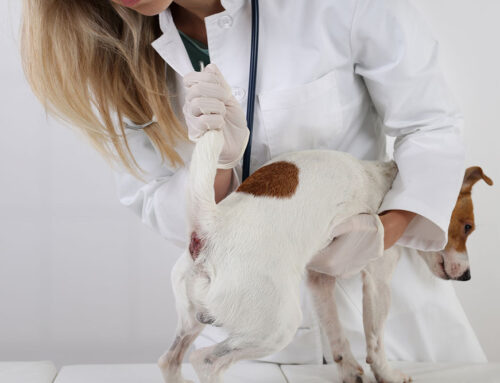When the Unthinkable Happens: Responding to Pet Trauma
Car accidents, falls, or fights can happen in seconds and leave pets seriously injured. Knowing how to respond, keeping your pet calm, stabilizing wounds, and seeking emergency care, can make a life-saving difference. Quick action and proper handling are the keys to recovery after trauma.
At the Veterinary Emergency and Specialty Center of Northern Arizona, our board-certified emergency veterinarians and state-of-the-art diagnostics, including Northern Arizona’s only CT scanner, provide the advanced care your pet needs when every second counts. Our 24-hour emergency services ensure that help is always available when the unexpected happens.
Why Internal Injuries in Pets Demand Immediate Attention
External wounds like cuts or limping are obvious, but internal injuries often hide beneath the surface. These hidden traumas can be far more dangerous because they progress rapidly without visible warning signs.
Internal bleeding, organ damage, and respiratory compromise can escalate within minutes to hours. Pets may appear stable initially, only to deteriorate suddenly as bleeding continues or organs fail. Shock develops when the body can no longer maintain adequate blood flow, leading to organ failure and death without intervention.
Prompt veterinary assessment is critical. Even if your pet seems fine after an accident, internal injuries may be brewing. The sooner we identify and treat these conditions, the better the outcome.
Recognizing Life-Threatening Internal Injuries in Pets
Understanding the types of internal trauma that can occur helps you recognize when your pet needs emergency care. These injuries often result from blunt force trauma such as vehicle accidents, falls from heights, or attacks by larger animals.
Abdominal Bleeding and Splenic Rupture in Pets
The spleen is particularly vulnerable during traumatic events. When ruptured, it causes hemoabdomen, free blood in the abdominal cavity, which can lead to life-threatening blood loss. Internal bleeding can progress rapidly without visible signs.
Warning signs include:
- Sudden weakness or collapse
- Distended or firm abdomen
- Pale or white gums
- Rapid, shallow breathing
Surgical intervention is often required to stop the bleeding and remove damaged tissue. Without treatment, pets can bleed to death internally while showing minimal external signs.
Chest Trauma and Breathing Complications
Thoracic trauma in pets affects the chest cavity and can damage the lungs, heart, or major blood vessels. Rib fractures may puncture lung tissue, while blunt force can cause lung contusions that impair oxygen exchange.
Hemothorax in cats and dogs occurs when blood fills the chest cavity, compressing the lungs and making breathing increasingly difficult. Pets with chest injuries may refuse to lie down, breathe with their mouth open, or adopt an abnormal posture to ease discomfort. Some may also experience diaphragmatic hernias when trauma forces abdominal organs into the chest cavity.
Rapid stabilization with oxygen therapy and chest drainage can be lifesaving. Our emergency team monitors respiratory function closely and provides immediate intervention when breathing becomes compromised.
Other Critical Internal Injuries in Dogs and Cats
Not all internal trauma involves bleeding. Pulmonary contusions bruise lung tissue without causing visible blood loss but still impair breathing. Diaphragmatic hernias allow abdominal organs to shift into the chest cavity, restricting lung expansion.
Pancreatic trauma can trigger dangerous inflammation, while kidney or bladder rupture releases urine into the abdomen, causing toxicity and infection. These injuries may develop more slowly but require the same urgent attention as bleeding emergencies.
What Pet Owners Should Watch For After Trauma
Recognizing the early signs of internal injury can mean the difference between life and death. Even if your pet seems stable after an accident, watch closely for these red flags:
- Pale, white, or blue-tinged gums
- Labored, rapid, or shallow breathing
- Sudden weakness, collapse, or inability to stand
- Abdominal swelling, firmness, or visible bruising
- Lethargy, hiding, or reluctance to move
- Vomiting or inability to keep water down
If you notice any of these signs, contact our emergency team immediately. Time is critical, and waiting to see if symptoms improve can allow conditions to worsen beyond repair.
First Steps to Take While Seeking Emergency Care for Your Pet
Your actions in the first moments after trauma can stabilize your pet until veterinary help is available. Follow these steps while arranging transport:
- Restrict movement. Keep your pet as still as possible to prevent further injury. Use a flat board or blanket as a stretcher for larger dogs.
- Monitor breathing and gum color. Check if your pet is breathing normally and note the color of their gums. Pale or blue gums indicate poor oxygen circulation.
- Avoid food and water. If surgery is needed, an empty stomach reduces anesthesia risks. Withhold all food and water until your veterinarian advises otherwise.
- Prepare for safe transport. Secure your pet in a carrier or crate to prevent sudden movements. Drive carefully but quickly to avoid delays.
Basic first aid for dogs and cats can buy precious time in emergencies. Knowing how to stop bleeding, check vital signs, and move an injured pet safely can make a significant difference while you travel for care. The ASPCA’s emergency care guide also provides simple steps to stabilize your pet until you reach a veterinary professional.
Do not attempt to treat bleeding or fractured limbs at home without veterinary guidance. Well-intentioned interventions can sometimes worsen injuries or delay proper treatment.
How Veterinarians Diagnose Hidden Internal Injuries in Pets
Advanced diagnostics reveal what physical examination alone cannot detect. At the Veterinary Emergency and Specialty Center of Northern Arizona, our comprehensive approach combines laboratory testing and cutting-edge imaging to assess the full extent of trauma.
Laboratory Testing for Trauma Assessment in Pets
Blood work in trauma cases provides critical information about your pet’s internal condition. Complete blood counts reveal anemia from internal bleeding, while chemistry panels assess kidney, liver, and pancreatic function.
Clotting profiles determine if your pet can form blood clots properly, essential information before any surgical intervention. Electrolyte panels identify imbalances that affect heart rhythm and muscle function.
Advanced Imaging for Accurate Diagnosis in Pets
Ultrasound examinations quickly identify free fluid in the chest or abdomen, indicating internal bleeding or organ rupture. This non-invasive tool allows our veterinarians to assess organ integrity and guide treatment decisions in real time.
Radiographs reveal bone fractures, organ displacement, and air where it shouldn’t be. Our CT scanner provides three-dimensional images that show complex injuries in extraordinary detail, particularly for head trauma, spinal injuries, and chest injuries.
Treatment Options for Pets with Internal Trauma
Treatment varies based on injury type and severity, but all cases require intensive monitoring and supportive care. Our experienced team provides comprehensive emergency and critical care tailored to your pet’s specific needs.
Stabilization measures include:
- Intravenous fluid therapy to maintain blood pressure
- Oxygen supplementation for respiratory support
- Blood transfusions to replace lost blood volume
- Pain management to keep your pet comfortable
Surgical intervention repairs damaged organs, controls bleeding, and removes non-viable tissue. Our emergency surgeons perform life-saving procedures around the clock, including exploratory surgery, splenectomy, and chest tube placement.
Post-operative care involves intensive monitoring in our critical care unit. We track vital signs continuously, adjust treatments as needed, and provide the compassionate support your pet needs during recovery. Financing options through Scratch Pay help ensure that cost doesn’t delay necessary treatment.
When Every Second Counts: Recognizing True Emergencies in Your Pet
Some situations require immediate emergency care without delay. If your pet experiences any of the following, bring them to our 24-hour facility right away:
- Persistent weakness, collapse, or inability to stand
- Severe difficulty breathing or gasping
- Pale, white, or blue gums
- Rapid abdominal swelling
- Extensive bruising across the body
- Seizures following head trauma
Limping, visible pain, or stiffness after injury should also be evaluated promptly. Pets showing sudden stiffness, trembling, or reluctance to move may also display common signs of pain that warrant urgent evaluation.
In addition, burns from electrical cords, stoves, or chemicals can cause severe tissue damage.
Our emergency veterinarians are affiliated with the American College of Veterinary Emergency and Critical Care and the American Veterinary Emergency and Critical Care Society, ensuring that your pet receives gold-standard care from specialists trained in managing life-threatening conditions.

Protecting Your Pet Through Vigilance and Prompt Action in an Emergency
Regular wellness visits help establish baseline health, making it easier to recognize when something is wrong. But when accidents happen, trust your instincts. If something seems off after trauma, don’t wait to see if it improves. Preventing pet emergencies through preparation, supervision, and safe environments is the best protection.
The Veterinary Emergency and Specialty Center of Northern Arizona bridges the gap between gold-standard human and veterinary medicine, bringing world-class emergency care to your pet when they need it most. Our 24-hour availability, advanced diagnostics, and board-certified specialists provide the expertise and technology necessary to save lives.
Contact us immediately if your pet experiences trauma of any kind. When the unthinkable happens, we’re here to help you through it.







Leave A Comment